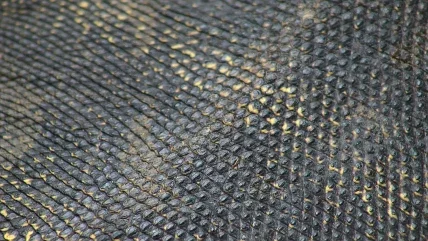
The hides/skins are susceptible for bacterial attack once flayed from the animal. The normal time lapse between skinning and tanning process of green hides/skins demands a temporary preservation technique. Conventionally, a salt (30–40% w/w)-based preservation technique is widely practised where the salt acts as a dehydrant. The conventional salt-based dehydration technique demands for additional steps such as rehydration in subsequent leather processing, which consumes huge amount of water. Therefore, the conventional dehydration-rehydration model results in the generation of a huge amount of waste water with increased total dissolved solids (TDS) load.
On the other hand, the removal of TDS from waste water requires sophisticated techniques like membrane filtration or reverse osmosis, which increase the cost of the waste water treatment process. This limitation can be capitalised on by way of providing a suitable alternative for the elimination of the rehydration step in leather processing. Several attempts have been made to develop less-salt and salt-free preservation techniques to reduce the TDS load in waste water. However, significant reduction in TDS has not been achieved.
Polymeric compound-based preservation techniques have been developed using various molecular weight of polyethylene glycol (PEG). However, the cost of PEG is higher than the conventional salting technique. Some attempts have been made to develop new preservation techniques thatt avoid the rehydration step (soaking) in leather manufacturing.
Chandrababu 2012 provided a method for direct transportation of flayed hides/skins to tanneries by employing a mobile chiller (4°C), which eliminates the rehydration step, but the process is energyintensive. The addition of ice to the raw stock would preserve the hides/skins, and this method is being followed on larger scale in Switzerland, Germany and Austria; however, the process is applicable only for a short duration. In order to increase the process efficiency, preservative containing ice has been employed in the preservation process. However, the major limitation of the process is the draining of liquor containing a high concentration of preservative. Short-term preservation can also be achieved by spraying bactericides and employing various plant extracts. Bailey & Hass 1988 provided an irradiation technique where gamma rays or electron beam applied on the hides/skins followed by packing in separate airtight bags for effective preservation. However, the process suffers from the requirement of skilled labour, high cost of investment and sophisticated instrumentation system.
Unhairing is a sequential process after soaking where the combination of lime and sodium sulphide is used conventionally as unhairing agents. But the major limitations are the generation of lime sludge and the possible release of toxic hydrogen sulphide gas during subsequent leather processing or from effluent treatment plant. Heidemann’s Darmstadt process deals with spraying 10% sodium sulphide solution on the hair side of hides/skins and hung for 10–20 minutes. The degradation of the epidermis layer enables the easy removal of hair and the residual sulphide present in the skin matrix is further oxidised with 10% sodium peroxide solution. Though the process is effective, the toxic sodium sulphide has not been replaced. Some attempts have been made to use hydrogen peroxide, calcium peroxide and sodium percarbonate as sulphide-free sharpening agents (oxidative unhairing), but it required a higher quantity than sulphide, which in turn increases the process cost.
The replacement of sulphide with thioglycolate , sirolime and dimethylamine is less effective and its odour makes the working atmosphere unpleasant. In acidic unhairing, concentrated acetic acid and salt is applied on the flesh side of fresh skins and stored overnight. Due to the combined actions of the lyotropic effect induced by acetic acid and autolytic enzymes present in the skin matrix on basement membrane, this enables selective removal of epidermis from the grain surface. Though the process eliminates the lime and sulphide, it is not suitable for dried and salted skins. Schlosser 1985 used the lactobacillus culture, which selectively destroy the epidermis layer of the skin matrix thus enabling hair loosening. However, the addition of salt is required to prevent acid swelling due to the formation of lactic acid during the fermentation process, which increases the TDS load.
Several attempts have been made to use enzymes for the development of a chemical-free unhairing process, but the process cost is higher than the conventional lime/sulphide-based system. Therefore, the development of a preservation technique without dehydrating the hides/skins matrix simultaneously enabling a lime-free and low-sulphide unhairing process is essential in order to reduce the water consumption profile and pollution generation of the pre-tanning process.
Materials and methods: efficiency and analysis
Raw sheep skins were procured from Permabur slaughter house in Chennai, Tamil Nadu, India, and transported to a CLRI pilot tannery within two hours under cold conditions and cut along the back bone. All the left halves were subjected to conventional salt-based preservation and the right halves were treated with the developed PCU formulation. The preservation efficiency was monitored based on the hydroxyproline release from preserved skin. After the preservation period of 30 days, the salted skins were soaked, unhaired and chrome-tanned as per the conventional process. The PCU-processed skins were subjected to manual unhairing followed by lime-based fibre opening and converted into wet-blue leather in a conventional way. The wet-blue leathers obtained from both the salted and PCU process were converted into crust leathers.
The physical properties such as tensile strength, percentage elongation at break (IUP 6 2000), tear strength (IUP 8 2000), grain crack load and distension at grain crack of crust leathers obtained from conventional and PCU processes were analysed. The specimens for physical testing as mentioned above were obtained as per IULTCS standard method and conditioned for 24 hours at 25°C and 65% RH (IUP 2 2000). The crust leathers were also evaluated for various organoleptic properties such as softness, grain smoothness, fullness, grain flatness and overall appearance by hand and visual examination. Each property was rated on a scale of one to ten, where a higher point indicates better properties.
Waste water discharged from conventional and PCU-based preservation systems was subjected to COD, TS, TDS, TSS, TKN and Cl analysis as per the standard method.
Results and discussion: the PCU process
Preservation efficiency of the developed PCU process has been monitored over a period of 30 days.
It is evident from Figure 1 that the hydroxyproline release increases with increasing time and reaches a maximum of 320mg/kg for the conventional process and 356mg/kg for the PCU process. It is clear that there is no significant increase in hydroxyproline for the PCU process over the salted technique. Therefore, it can be perceived that the preservation efficiency of the developed PCU process is on par with the conventional process.
The crust leathers obtained from conventional (salt) and experimental (PCU) processes have been subjected to various physical strength characteristics measurement and the results are given in Table 1. It has been observed from Table 1 that the physical strength characteristics of PCU-treated leathers are on par with the conventionally processed leathers.
The organoleptic properties of crust leathers have been rated on a scale of one to ten. Higher points indicate better properties of final leather. The results indicate that the PCU leather exhibits better softness (9/10) and grain smoothness (9/10) than the conventionally processed leather (softness 8/10, smoothness 8/10). But, the fullness and grain flatness of conventional leather (8 /10) is slightly higher than PCU leather (7.5/10).
The waste water characteristics of soak liquor discharged from salt and PCU preservation system have been analysed and the results are given in Table 2. It is evident from Table 2 that the pH of soak liquor from PCU and salted system is almost similar. Total solids discharged from conventional process is about 268kg/t, whereas for PCU system is only about 41kg/t. The other parameters like TDS/ TSS have also been significantly reduced in the PCU process due to the complete elimination of salt.
Conclusions
In this work, the preservation and unhairing process have been successfully interconnected through the development of a preservation-cumunhairing process. And the developed system reduces 85% of pollution load discharged from the soaking process in addition to eliminating the lime and reducing the toxic sodium sulphide required for the hair removal process. Therefore, the developed preservation-cum-unhairing process would be a promising technology lead for sustainable leather manufacturing.






